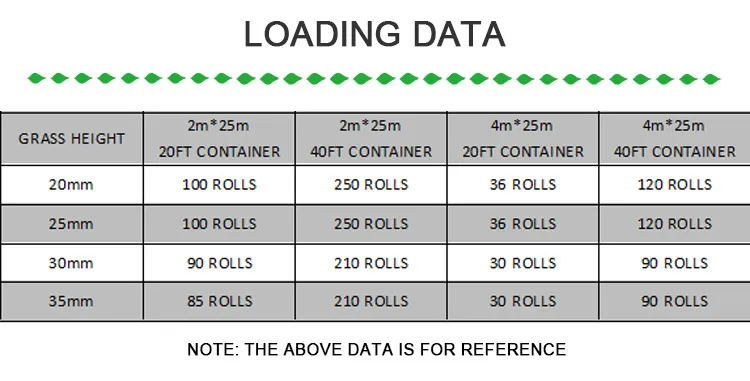
- Afrikaans
- Arabic
- Belarusian
- Bengali
- Czech
- Danish
- Dutch
- English
- Esperanto
- Estonian
- Finnish
- French
- German
- Greek
- Hindi
- Hungarian
- Icelandic
- Indonesian
- irish
- Italian
- Japanese
- kazakh
- Rwandese
- Korean
- Kyrgyz
- Lao
- Latin
- Latvian
- Malay
- Mongolian
- Myanmar
- Norwegian
- Persian
- Polish
- Portuguese
- Romanian
- Russian
- Serbian
- Spanish
- Swedish
- Tagalog
- Tajik
- Thai
- Turkish
- Turkmen
- Ukrainian
- Urdu
- Uighur
- Uzbek
- Vietnamese
turf grass for football field
Nov . 15, 2024 00:36 Back to list
The Importance of Turf Grass for Football Fields
Football is one of the most popular sports worldwide, and it is played on various surfaces, including grass and artificial turf. However, natural turf grass remains the preferred choice for many professional football fields due to its environmental benefits, player safety, and aesthetic appeal. This article will explore the importance of turf grass for football fields, discussing its benefits, maintenance requirements, and impact on gameplay.
Benefits of Natural Turf Grass
1. Player Safety One of the foremost reasons clubs opt for natural turf grass is player safety. Natural grass provides a cushioning effect, reducing the likelihood of injuries such as slips, falls, and impacts. In contrast, artificial turf can be harder and more abrasive, potentially increasing the risk of scrapes and concussions.
2. Environmental Benefits Turf grass contributes significantly to the environment. It absorbs carbon dioxide and releases oxygen, improving air quality. Furthermore, grass helps manage rainwater runoff by allowing water to seep into the ground, which reduces the risk of flooding and erosion. Additionally, natural grass fields support biodiversity by providing habitats for various organisms.
3. Aesthetic Appeal A well-maintained natural grass field offers a beautiful and vibrant appearance, enhancing the overall experience for players and spectators alike. The lush green of real grass creates an inviting atmosphere and is often associated with tradition and authenticity in sports.
4. Temperature Regulation Natural grass has a cooling effect, particularly in hot weather. Grass helps regulate the temperature of the playing surface, which not only enhances player comfort but also minimizes heat-related injuries during matches.
Maintenance of Turf Grass
While natural turf grass has numerous benefits, it requires dedicated maintenance to ensure optimal playing conditions. Regular tasks include
- Mowing Keeping the grass at the right height is essential. Generally, football fields should be mowed to a height of about 1.5 to 2 inches. This height supports healthy growth while ensuring a playable surface.
turf grass for football field

- Aeration Aerating the soil helps reduce compaction, allowing air, water, and nutrients to penetrate deeper into the root zone. This process is vital for maintaining healthy grass and supporting root development.
- Fertilization Applying fertilizer provides essential nutrients that promote growth and resilience. The type and timing of fertilizer application can significantly influence the health of the turf.
- Watering Proper irrigation is crucial, especially in dry seasons. Grass requires a consistent watering schedule to maintain moisture levels, typically around 1 to 1.5 inches per week, depending on the climate and type of grass.
- Pest and Weed Control Regular monitoring for pests and weeds is necessary to prevent infestations and competition for resources. Integrated pest management strategies can help control these issues effectively.
Impact on Gameplay
The quality of the turf grass has a direct impact on gameplay. A well-maintained field enhances ball roll, allows for better traction, and minimizes the chances of injury. On the other hand, poorly maintained turf can lead to unpredictable bounces, muddy conditions, and increased injury risks.
Famous stadiums that feature natural turf, such as Wembley Stadium and the Camp Nou, highlight the significance of quality grass in elite football. Players often express a preference for natural surfaces, as they provide a more consistent and enjoyable playing experience.
Conclusion
Turf grass plays a vital role in the world of football, combining aesthetic appeal, environmental benefits, and safety for players. All stakeholders, from clubs to groundskeepers, must prioritize the maintenance of natural grass fields to ensure they remain in optimal condition. By investing in quality turf grass, the football community not only enhances the sport itself but also protects the health and safety of its players while contributing positively to the environment. As the game continues to evolve, the appreciation and understanding of turf grass's significance will only grow, reminding us that sometimes, traditional methods yield the best results.
-
The Benefits of Artificial Turf for Indoors
NewsJul.15,2025
-
How Artificial Grass Suppliers Ensure Quality Products
NewsJul.15,2025
-
Artificial Grass and Pets: A Space for Relaxation
NewsJul.08,2025
-
Balcony & Outdoor Decoration with Artificial Grass
NewsJul.08,2025
-
Best Indoor Artificial Grass for Home
NewsJul.07,2025
-
Best Pet Turf for Dogs: Safe & Durable Artificial Grass Options
NewsJul.07,2025
Products categories









